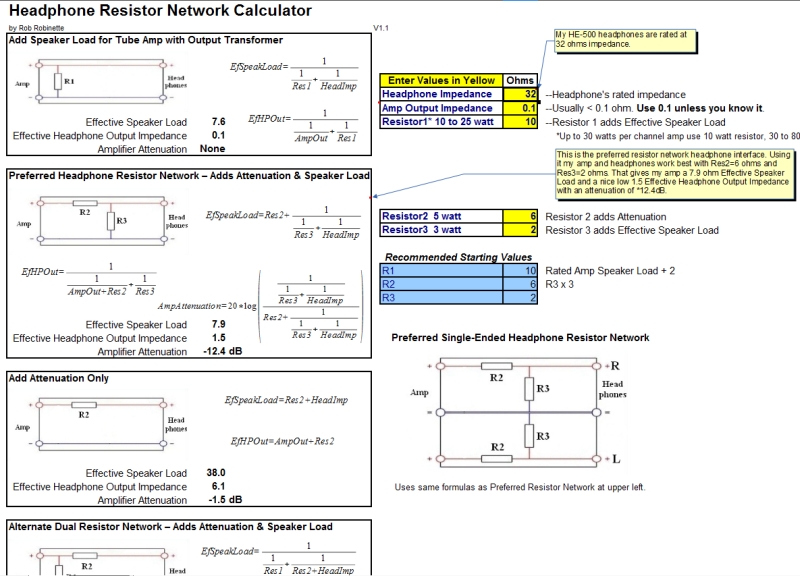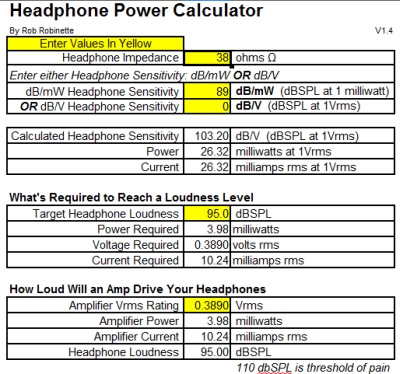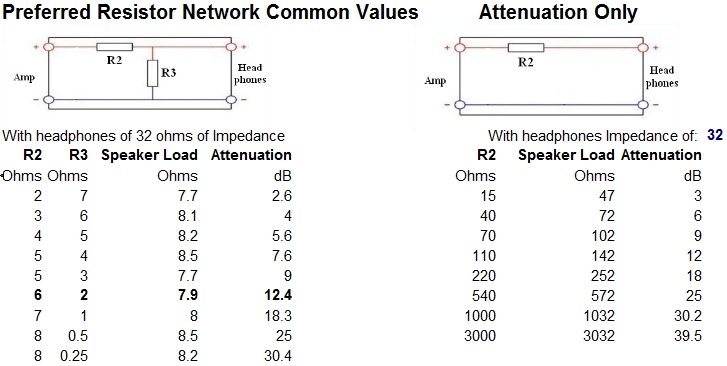Instructions
A headphone resistor network interface helps to electrically match a pair of headphones to a speaker amplifier's speaker terminals. The resistor network used on this page is a simple L-pad attenuator and is the most commonly recommended headphone-to-speaker-amp resistor network interface, so much so I refer to this two resistor network as the "Preferred Headphone Resistor Network."
1. Input your Headphone's Impedance rating and the Amplifier's Output Impedance (if you don't know it leave it at 0.1).
2. Click the "Calculate" button
3. A Resistor2 value of 6 ohms and Resistor3 value of 2 ohms will be close to optimal for most headphones and speaker amps but be sure and play around with the value of Resistor2 and Resistor3 and recalculate to see what happens. The goal is to match your Effective Speaker Load with your amp's speaker load rating (usually 8 ohms). If your speaker amp needs 4 ohms of speaker load then use an R2 of 3 ohms and an R3 of 1 ohm to get 4 ohms of effective speaker load and 12.4 dB of attenuation. For an amp that needs 16 ohms of speaker load use 12 ohms and 4 ohms to get 16 ohms of effective speaker load.
The greater the ratio between Resistor2 and Resistor3 the higher the Amp Attenuation. Resistor2 should be rated at 5 watts or more and Resistor3 should be rated at 3 watts or more. Both should be wire wound non-inductive Resistors.
4. The Amp Attenuation value is used to indicate how much of your amp's power will be dissipated by the network and lower its output to the headphones. The higher the Amp Attenuation the lower the amp's output which can help in two ways: More Attenuation can help reduce the amp's noise floor hiss that can sometimes be heard using headphones (especially sensitive headphones) with speaker amps. A common problem with using a speaker amp with headphones is lack of volume control because a little knob movement can give a big volume increase. Adding amp attenuation can give you more useable volume knob movement.
More on Amplifier Attenuation
How much attenuation you need depends on your headphone's impedance and sensitivity and your amp's power rating. My HiFiMAN HE-500 headphones are rated at 38 ohms impedance, 89 dB/mW (decibel at 1 milliwatt) and 103.2 dB/V (decibel at 1 Vrms or volt root-mean-square). The He-500 is known as a sensitive, relatively easy to drive high end headphone. Headphone sensitivity is important for comparing headphone loudness and determining how much attenuation is needed. The higher the headphone sensitivity rating and the more powerful the amplifier the more attenuation is needed.
The Sennheiser HD800, Sennheiser's top of the line headphone, is moderately difficult to drive with ratings of 300 ohms impedance, 96.8 dB/mW and 102 dB/V sensitivity.
The HiFiMAN HE-6 is known as one of the most difficult to drive headphones on the market. It's rated at a low 50 ohms impedance but a paltry 83.5 dB/mW and 96 dB/V sensitivity. With most speaker amplifiers the HE-6 would need no attenuation at all. In this case you could simply delete Resistor2 from the resistor network. A 10 ohm 10 watt Resistor3 would supply the amp with 7.6 ohms of Effective Speaker Load to keep it happy.
For you Android phone or tablet users there's a free Headphone Calculator for Android available in the Google Play Store or direct download here: Headphone Calculator for Android It does both network and power calculations.
Download my much more detailed Excel spreadsheet Headphone Resistor Network Calculator. It calculates 1, 2, 3 and 4 resistor networks.
To calculate headphone sensitivity and power requirements download my Headphone Power Calculator Spreadsheet.
Additional Information
Balanced and Single-Ended Headphones
This network interface can be used with balanced or unbalanced (single-ended) headphones. If you do plan to use this network interface with single-ended headphones make sure your amplifier has the two black speaker terminals tied together. To verify this unplug your amp and use a multimeter's continuity function and touch the two probes to the black speaker terminals and listen for the continuity beep. If the two black speaker terminals are not tied together (no beep) do not connect single-ended headphones to it or you may damage or destroy the amp and/or headphones.
Single-Ended Headphone Network
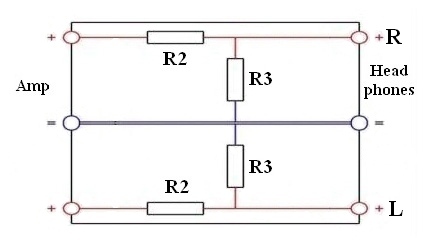
The headphone cable's shield carries the combined common ground negative signal.
Basic Speaker Amp to Headphone Adapter - Single Ended TRS
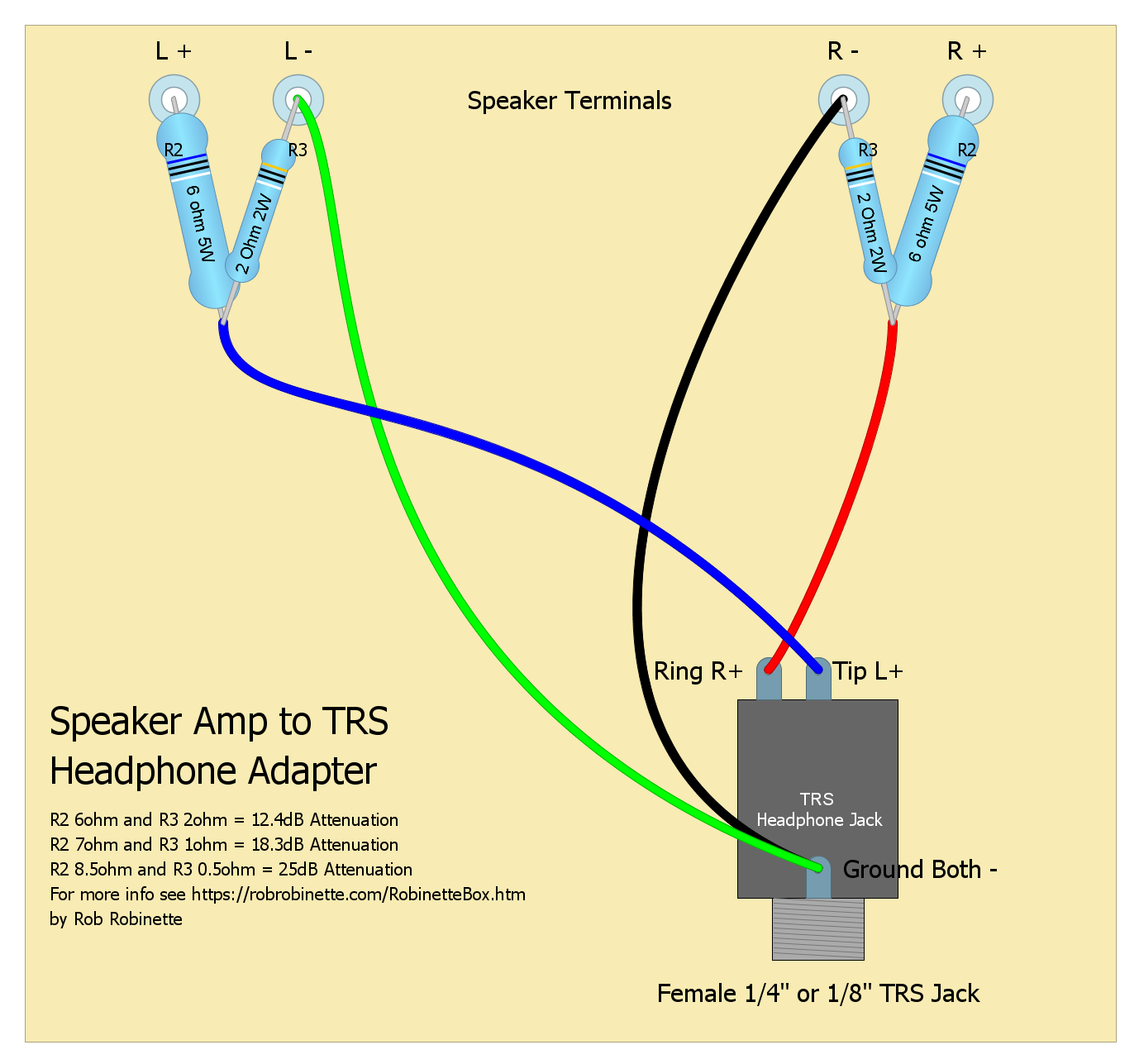
This type of adapter is only for amplifiers that have their negative speaker terminals tied together (common ground).
Basic Speaker Amp to Headphone Adapter - Balanced Output XLR 4-Pin
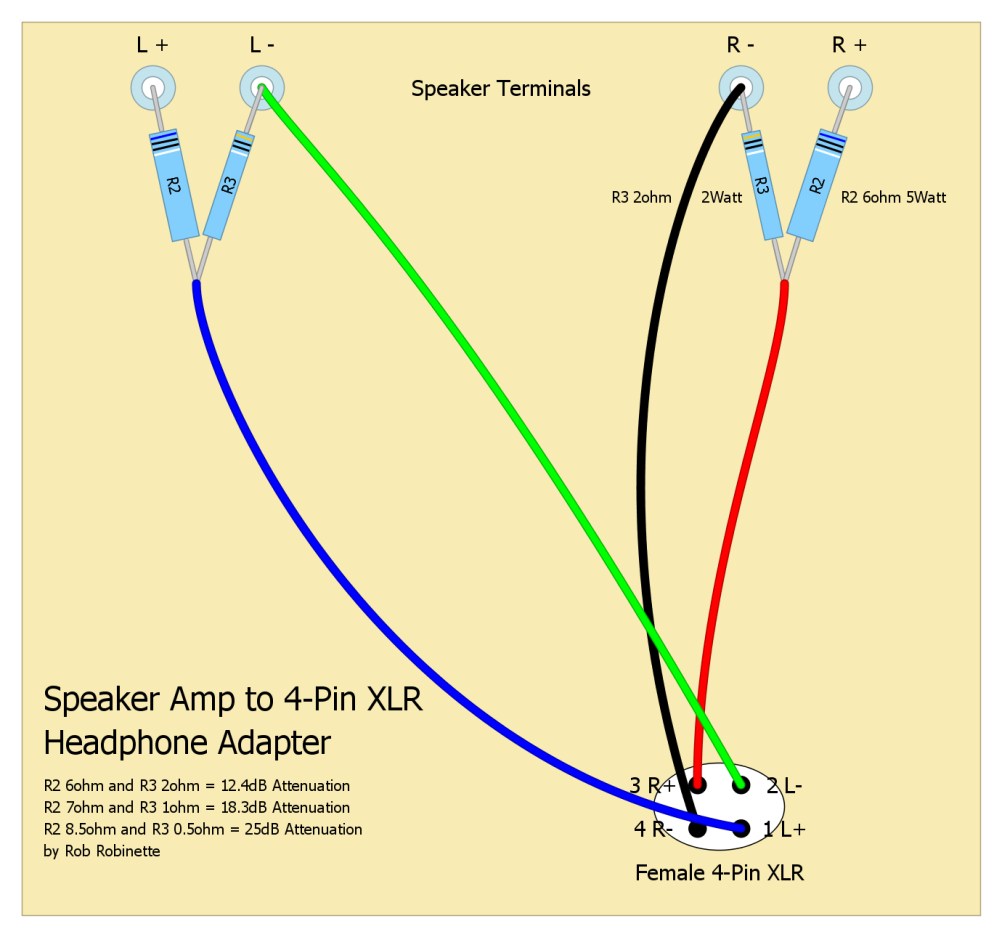
This adapter will work with single-ended and balanced output speaker amplifiers.
Connecting headphones directly to a speaker amplifier's speaker outputs can cause three problems:
1. Headphone impedance tends to run 4 to 75 times higher than speakers. This impedance mismatch can cause problems, especially for tube amplifiers that use output transformers. The Robinette Box's resistor network will feed your speaker amp 7.6 to 7.9 ohms of effective speaker load no matter the impedance of your headphones, even with three sets of low impedance headphones used simultaneously.
2. Excessive gain. Speaker amplifiers are made to move large amounts of air using big speakers. Connect them to sensitive headphones and the amp's noise floor may be audible as a hiss. The resistor network will attenuate the amp's output by over 12 dB (decibels) which will lower the noise floor and greatly reduce audible hiss.
3. Lack of useable volume control. You may find you can only turn your speaker amp's volume control 20 or 30% before you get to your max listening level. The resistor network's 12.4 dB of attenuation will give you more useable volume knob movement allowing more precise volume setting.
Before building a headphone network interface I recommend you connect your headphones directly to the speaker amp and listen. Here's how to make a balanced headphone-to-speaker-amp adapter cable or see this page to make a single-ended headphone adapter cable. Make sure the amp is off or unplugged as you connect the headphones and turn the volume completely down before turning on your amp. Then slowly turn up the volume. Many amps will sound great without an interface.
Because headphones are so sensitive you can sometimes hear amplifier noise floor hiss when connected direct. Also sometimes you'll end up with only being able to turn your amp up just a little before the volume is too loud. This resistor network interface can solve the hiss and volume knob problem by adding attenuation to dissipate some of the amp's output power. The hiss will be less noticeable and you'll have more useable volume knob movement to adjust your listening level.
Most solid state (non-tube) amplifiers will have no problem driving headphones of any impedance so you can add attenuation by simply adding a resistor to each stereo channel's positive wire (no need for Resistor 3). Typically a 50 to 100 ohm 3 watt resistor will do the trick.
The advantage of using the headphone resistor network on this page is that it will add attenuation and also give your amp the speaker load it was designed for. This can be especially critical with tube amplifiers that use output transformers. If you build the network interface shown on this page it will work with almost all amplifiers, tube or solid state.
Some common resistor values to reach a desired level of attenuation:
"Preferred Headphone Resistor Network" Circuit Analysis
or How the Resistor Network Works
Using my HE-500 headphones we'll analyze the "Preferred Resistor Network" using Ohm's Law. Inputting the HE-500's specs of 38 ohms impedance and 89 dB/mW sensitivity into the Headphone Power Calculator spreadsheet shows:
So with my HE-500s connected directly to an amplifier providing 0.389 volts RMS you get 10.24 milliamps (0.01024 amps) of current flowing through the headphones and 95 dBSPL Vrms of loudness. That loudness level would be too loud for most headphone listeners.
Using our Resistor Network Calculator on this webpage we input Headphone Impedance = 38 ohms, and the standard "Preferred Network" resistor values of R2 = 6 ohms, R3 = 2 ohms:
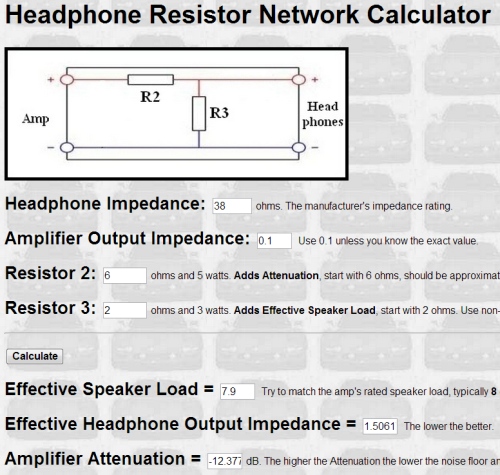
The calculated "Effective Speaker Load" is the total Headphones + "Preferred Network" circuit impedance/resistance of 7.9 ohms and Attenuation is shown as -12.37 dB.
Now lets plug the 0.389 volts from the amplifier and the 7.9 ohms of total circuit resistance into our "preferred network" and analyze it using Ohm's Law.
The "Preferred Headphone Resistor Network"
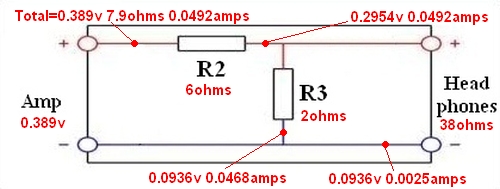
Amplifier puts out 0.389 volts, R2 drops the voltage to 0.2954v, R3 and the Headphones drop the voltage to 0.0936v. Of the 0.0492 amps from the amplifier only 0.0025 amps go through the Headphones.
First we calculate the total circuit current using Ohm's formula: Current = Volts / Resistance = 0.389v / 7.9ohms = 0.0492 amps of current (or 49.2 milliamps). We can also calculate the total circuit Power (watts) using: Watts = Volts^2 / Ohms = 0.389v^2 / 7.9ohms = 0.0192 watts (19.2 milliwatts). So the amplifier is putting out 0.389 volts, 0.0492 amps and 0.0192 watts.
Now we can calculate the voltage drop caused by resistor R2's 6 ohms. All 0.0492 amps of current run through R2 so we can use the formula: Volts = Current * Resistance = 0.0492amps * 6ohms = 0.2954 volts (295.4 millivolts). We can also calculate the watts dissipated by R2 using the formula Watts = Amps^2 * Ohms = 0.0492amps^2 * 6ohms = 0.0145watts.
Since our Headphones are in parallel with resistor R3 they will both get 0.2954 volts but the 0.0492 amps will be divided between them.
To determine how the current is split between R3 and the Headphones we must first calculate the resistance of R3 + Headphones in parallel. The formula is 1 / (1 / R3 + 1 / Headphones) = 1 / (1 / 2ohms + 1 / 38ohms) = 1.9 ohms. Using Windows Calculator in scientific mode (View/Scientific) the keystrokes for this calculation would be: 2 + 38 gives 1.9 ( is the reciprocal key).
Now we can calculate the voltage drop across R3 and the Headphones. The formula is: Volts = Current * Resistance = 0.0492 * 1.9ohms = 0.0936 volts (93.6 millivolts).
Knowing the voltage drop across R3 and the Headphones we can calculate the current split through them. Lets start with R3. The formula is Current = Volts / Resistance = 0.0936v / 2ohms = 0.0468 amps flowing through R3. For the headphones it is 0.0936v / 38ohms = 0.0025 amps (2.5 milliamps) flowing through the headphones at 0.0936 volts (93.6 millivolts).
Now we can also calculate the watts dissipated by R3 using the formula Watts = Amps^2 * Ohms = 0.0468amps^2 * 2ohms = .00438 watts. The watts dissipated by the headphones is: 0.00246amps^2 * 38ohms = 0.00023 watts (0.23 milliwatts).
We can use Kirchhoff's Voltage Law to double-check our voltage calculations. The law states that the sum of all voltages around a closed circuit is equal to zero. Sure enough we add the output voltages of R2 + (R3 & Headphones) = 0.2954v + 0.0936v and subtract that from the amplifier output of 0.389 volts and you get 0.
So our amplifier puts out 0.389 volts, 0.0492 amps and 0.0192 watts
And the resistor network drops that to 0.0936 volts (93.6 millivolts), 0.00246 amps (2.46 milliamps) and 0.00023 watts (0.23 milliwatts) through the headphones.
We can plug our calculated 0.0936 volts at the headphones into the Headphone Power Calculator spreadsheet:
With 0.0936 volts RMS getting through the resistor network to the headphones you get a nicely matching 2.46 milliamps and 0.23 milliwatts and a loudness of 82.64 dB. If we compare this loudness to the 95.0 dB of the headphones connected directly to the amplifier we get an attenuation of: 82.64dB - 95.0dB = -12.36 dB which matches the attenuation calculated by the Headphone Network Calculator on this webpage.
Resistor Network Interface With XLR and Switched 1/4" and 1/8" TRS Headphone Jacks
The Robinette Box is a headphone to speaker amplifier interface box. It's designed to electronically match your headphones to a speaker amplifier's speaker output. Four resistors are used to give your amplifier its expected speaker load and to add attenuation to lower the amp's noise floor hiss and increase the useable volume knob movement.
The box features 1/4" (6.3mm) and 1/8" (3.5mm) Female TRS jacks for single-ended headphones and a Female 4-Pin XLR jack for balanced headphones. A toggle switch is used to switch between amplifiers with single-ended output and amps with balanced output. You can also bypass the resistor network at the flip of a switch.
Robinette Box Schematic
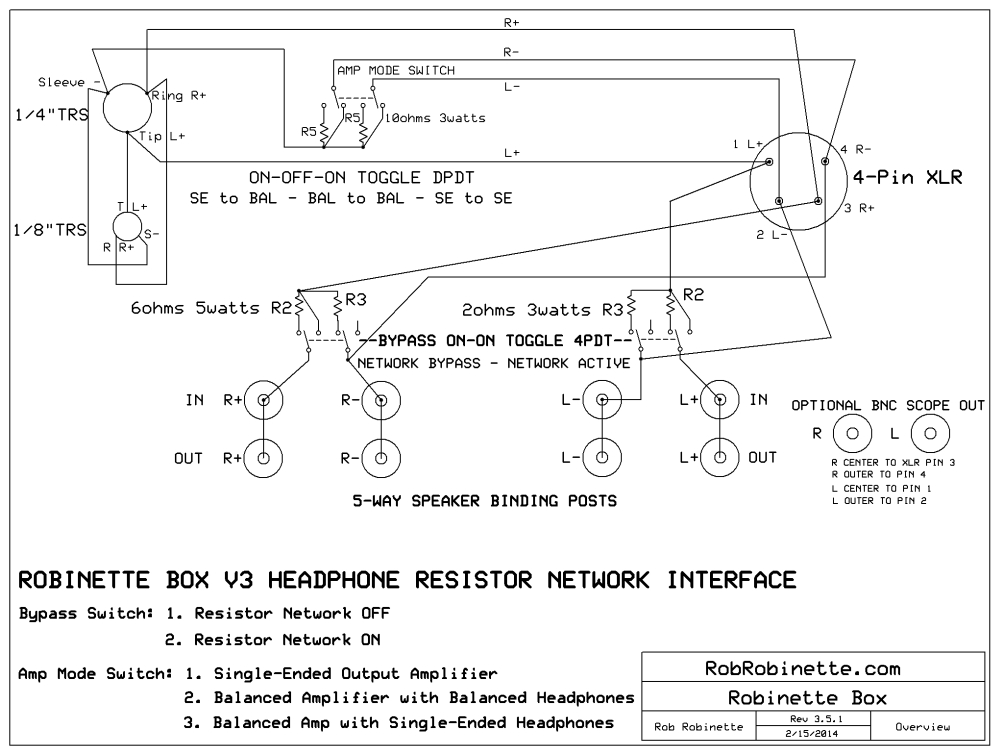
Amp Mode switch is shown in the "Single-Ended Output" position with all three headphone jacks useable. With the switch in the center position, "Balanced Output," only the 4-Pin XLR jack is useable. In the third "Single-Ended Headphones with Balanced Amp" position resistors R5 are used to protect the amp's balanced output. Go to the Robinette Box web page for info on how to build one.
Basic Speaker Amp to Headphone Adapter Box Resistor Network

Minimum resistor network supplies amplifier load and attenuation. R2 = 6 ohms 5 watts, R3 = 2 ohms 3 watts.
Formulas Used

EfSpeakLoad = Effective Speaker Load
EfHPOut = Effective HeadPhone Output impedance
HeadImp = rated Headphone Impedance
AmpOut = Amp Output impedance (usually < 0.1)
ResX = Resistor
